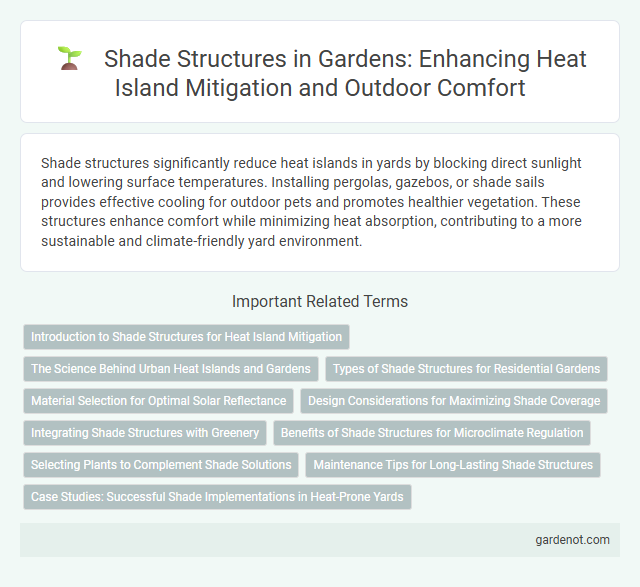Shade structures significantly reduce heat islands in yards by blocking direct sunlight and lowering surface temperatures. Installing pergolas, gazebos, or shade sails provides effective cooling for outdoor pets and promotes healthier vegetation. These structures enhance comfort while minimizing heat absorption, contributing to a more sustainable and climate-friendly yard environment.
Introduction to Shade Structures for Heat Island Mitigation
Shade structures play a critical role in heat island mitigation by reducing surface and air temperatures in urban yards through blocking direct solar radiation. Materials such as reflective fabrics, metal, or wood can efficiently provide shade while promoting airflow to lower localized heat buildup. Incorporating strategically placed shade structures, like pergolas and canopy systems, enhances outdoor comfort and reduces energy consumption linked to cooling.
The Science Behind Urban Heat Islands and Gardens
Shade structures in urban gardens play a crucial role in mitigating heat islands by reducing surface temperatures through blocking direct solar radiation. Strategically placed trees and pergolas create microclimates that lower ambient air temperatures by promoting evapotranspiration and providing shaded areas, which enhances human comfort. Research shows that integrating green infrastructure with shade elements can decrease urban heat effects by up to 5degC, contributing to more sustainable and livable city environments.
Types of Shade Structures for Residential Gardens
Pergolas, retractable awnings, and shade sails offer versatile shade solutions for residential gardens, enhancing outdoor comfort and reducing heat absorption. Pergolas provide a sturdy framework supporting climbing plants or fabric covers, creating a natural cooling effect. Shade sails, made from UV-resistant materials, effectively block sunlight and can be easily adjusted to provide optimal shade throughout the day.
Material Selection for Optimal Solar Reflectance
Selecting materials with high solar reflectance for shade structures significantly reduces heat absorption and lowers surrounding temperatures. Reflective coatings, light-colored metals, and tensile fabrics with reflective properties maximize solar reflectance, enhancing thermal comfort in urban yards. Optimal material choices contribute to effective heat island mitigation by minimizing radiant heat buildup.
Design Considerations for Maximizing Shade Coverage
In heat island mitigation yards, shade structures must be designed with optimal orientation and size to maximize shade coverage throughout peak sun hours, reducing surface temperatures effectively. The selection of materials with high thermal resistance and durability enhances the cooling effect while ensuring longevity under varied weather conditions. Incorporating adjustable or layered shading elements allows dynamic control of sunlight penetration, improving comfort and energy efficiency in outdoor environments.
Integrating Shade Structures with Greenery
Integrating shade structures with greenery enhances heat island mitigation by combining physical shading and evaporative cooling from plants. Shade structures provide immediate relief from solar radiation, while surrounding greenery reduces ambient temperatures through transpiration and increased evapotranspiration rates. This synergy optimizes microclimate regulation, contributing to lower surface temperatures and improved comfort in urban yards.
Benefits of Shade Structures for Microclimate Regulation
Shade structures significantly reduce ambient temperatures by blocking direct solar radiation, helping to lower heat island effects in urban yards. They improve microclimate regulation by enhancing air circulation and reducing surface heat absorption, which contributes to cooler, more comfortable outdoor spaces. This temperature moderation supports energy savings by decreasing the need for artificial cooling in adjacent buildings.
Selecting Plants to Complement Shade Solutions
Selecting drought-tolerant, native plants enhances heat island mitigation by providing natural cooling and reducing energy use in shade structure yards. Incorporating trees with broad canopies such as oaks or maples maximizes shade coverage, complementing built structures effectively. Low-maintenance ground covers and shrubs improve soil moisture retention while minimizing heat absorption in urban landscapes.
Maintenance Tips for Long-Lasting Shade Structures
Regular inspection and cleaning of shade structures prevent dirt buildup and material degradation, extending their lifespan. Applying protective coatings on metal or wooden frames guards against rust and rot, ensuring durability in various weather conditions. Tightening loose bolts and repairing fabric tears promptly maintain structural integrity and reduce replacement costs over time.
Case Studies: Successful Shade Implementations in Heat-Prone Yards
Case studies on shade structures in heat-prone yards highlight the effectiveness of pergolas, shade sails, and tree canopies in reducing surface temperatures by up to 15degF. Research from urban heat island mitigation projects demonstrates that integrating native plant species with engineered shade solutions significantly improves microclimate comfort. Data from studies in Phoenix and Los Angeles confirm that properly designed shade structures not only lower ambient temperatures but also increase outdoor usability during peak heat hours.
Shade structure Infographic

 gardenot.com
gardenot.com